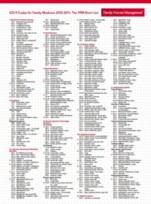
It's that time again, but this ICD-9 update is almost the last.
Fam Pract Manag. 2010;17(5):15-16
Cindy Hughes is the AAFP's coding and compliance specialist and is a contributing editor to Family Practice Management. Author disclosure: nothing to disclose.
Each fall in FPM, we outline the ICD-9 diagnosis code changes that take effect on Oct. 1. This year we bring you the usual annual updates. We do so, however, with the recognition that the ICD-9 code set is fast approaching its own new code assignment: V49.86, “Do not resuscitate.”
We expect that the last ICD-9 update will be on Oct. 1, 2011, at which time the code set will be frozen until ICD-10 takes effect on Oct. 1, 2013. The freeze will also prevent any updates to ICD-10 codes between Oct. 1, 2011, and Oct. 1, 2014, unless a disease emerges that requires a new code, such as a new influenza. The freeze will allow stability during this period so that health care providers, payers and others can modify their documents and systems to use ICD-10. We have a lot to look forward to.
ICD-9 CODING TOOLS
FPM's ICD-9 references have been updated to comply with the changes that take effect Oct. 1. “ICD-9 Codes for Family Medicine: The Short List” is
or at https://www.aafp.org/fpm/icd9, along with our ICD-9 “Long List,” superbill and PDA reference.

In the meantime, there are ICD-9 changes to implement on Oct. 1:
Health status codes. New V codes provide physicians additional means of reporting circumstances that affect the management of the patient's condition. We'll begin with the new V codes for reporting body mass index:
V85.41 Body mass index 40–44.9, adult,
V85.42 Body mass index 45–49.9, adult,
V85.43 Body mass index 50–59.9, adult,
V85.44 Body mass index 60–69.9, adult,
V85.45 Body mass index 70 and over, adult.
Also, report new code 278.03 for obesity hypoventilation syndrome.
To provide additional information when reporting postsurgical hypoinsulinemia (reported with existing code 251.3), physicians can now indicate whether the patient has undergone a total pancreas removal (code V88.11) or a partial removal (code V88.12).
Retained foreign bodies can now be indicated with any of 14 new codes in the V90.01-V90.9 series, which identify the material of the foreign body. These codes should be reported in addition to existing codes 360.61, “Foreign body in anterior chamber,” or 729.6, “Residual foreign body in soft tissue.”
Multiple gestation codes. New codes V91.00–V91.99 should be used to report placenta and gestation status, which were previously reported with codes in the still-valid 651 category. Any of the 17 new V codes should now be reported in addition to the appropriate 651.XX code.
Code V25.1 for insertion of an intrauterine contraceptive device is no longer valid. Use the following codes now:
V25.11 Encounter for insertion of intrauterine contraceptive device,
V25.12 Encounter for removal of intrauterine contraceptive device,
V25.13 Encounter for removal and reinsertion of intrauterine contraceptive device.
Continue reporting code V25.42 for routine checking of intrauterine contraceptive device. Most cervical and vaginal anomalies should now be reported with codes 752.43–752.47 instead of with code 752.49, which is still a valid code for “Other anomalies of cervix, vagina and external female genitalia.” Uterine anomalies previously reported with now-invalid code 752.3 should be more specifically reported with codes 752.31–752.39. Physicians can now indicate that a patient has a personal history of vaginal dysplasia with new code V13.23, or a personal history of vulvar dysplasia with new code V13.24.
Influenza. To specify pneumonia and other manifestations of avian or H1N1 influenza, see newly expanded codes 488.01–488.09 and 488.11–488.19.
Jaw pain. New code 784.92 can now be used to report jaw pain explicitly. Previously, jaw pain could only have been reported with code 526.9, “Unspecified disease of the jaws,” which is still a valid code.
Cognitive symptoms. New codes were introduced to better identify types of cognitive symptoms:
799.51 Attention or concentration deficit,
799.52 Cognitive communication deficit,
799.53 Visuospatial deficit,
799.54 Psychomotor deficit,
799.55 Frontal lobe and executive function deficit,
799.59 Other signs and symptoms involving cognition.
Neurogenic claudication. To recognize that a patient may have lumbar stenosis without neurogenic claudication, code 724.02 for spinal stenosis of the lumbar region has been revised and a new code has been added to indicate associated neurogenic claudication:
724.02 Spinal stenosis, lumbar region, without neurogenic claudication,
724.03 Spinal stenosis, lumbar region, with neurogenic claudication.
Hemochromatosis and fluid overload. Code 275.0 has been replaced with codes in the 275.01–275.09 range to allow specification of the cause of hemochromatosis. Also expanded is fluid overload, which was previously reported with code 276.6 and can now be reported as 276.61, “Transfusion associated circulatory overload,” or 276.69, “Other fluid overload.”
Post-traumatic seizures. Code 780.33, “Post-traumatic seizures,” has been added for acute symptomatic seizures following a head injury. This was previously reported with still-valid codes in the 345.00–345.91 range for epilepsy or with 780.39, “Other convulsions.”
Fecal incontinence. New codes 787.60–787.63 have been added to identify full incontinence of feces, incomplete defecation, smearing and urgency. Fecal impaction should be reported with new code 560.32, which has been assigned specifically for this condition. Physicians should no longer report still-valid code 560.39, “Other impaction of intestine,” for fecal impaction.
We hope that this update and the related resources from FPM (see “ICD-9 coding tools”) will help you manage the coming changes without incurring your own diagnosis: 339.42, “New daily persistent headache.”
ANXIOUS FOR (OR ABOUT) THE ARRIVAL OF ICD-10?
Check out the AAFP's ICD-10 web page. You'll find ICD-10 training resources, tools to help your practice create a transition plan, and more.
